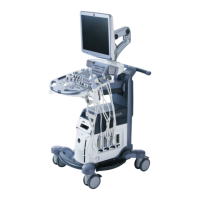2.6.3 Electrical Shock Hazard
The probe is driven with electrical energy that can injure the patient or user if live internal parts
are contacted by conductive solution:
•
DO NOT immerse the probe into any liquid beyond the immersion level.
'Probe
Maintenance'
on page 2-16
Never immerse the probe connector or probe adaptors into
any liquid.
•
DO NOT drop the probes or subject them to other types of mechanical shock or impact.
Degraded performance or damage such as cracks or chips in the housing may result.
•
Inspect the probe before and after each use for damage or degradation to the housing,
strain relief, lens, and seal. A thorough inspection should be conducted during the
cleaning process.
•
DO NOT kink, tightly coil, or apply excessive force on the probe cable. Insulation failure
may result.
•
Electrical leakage checks should be performed on a routine basis by GE Service or
qualified hospital personnel. Refer to the service manual for leakage check procedures.
2.6.4 Mechanical Hazards
A defective probe or excessive force can cause patient injury or probe damage:
•
Observe depth markings and do not apply excessive force when inserting or
manipulating intracavitary probes.
•
Inspect probes for sharp edges or rough surfaces that could injure sensitive tissue.
•
Avoid mechanical shock or impact to the transducer and do not apply excessive bending
or pulling force to the cable.
2.6.5 Cable Handling
Take the following precautions with probe cables:
•
Keep free from wheels.
•
Do not bend the cable acutely.
•
Avoid crossing cables between probes.
2.6.6 Ergonomics
Probes have been ergonomically designed to:
•
Handle and manipulate with ease.
•
Connect to the system with one hand.
•
Be lightweight and balanced.
•
Have rounded edges and smooth surfaces.
Cables have been designed to:
•
Connect to system with appropriate cable length.
Safety
Voluson® S6/S8 Basic User Manual
5433669-100 Revision 4 2-15

